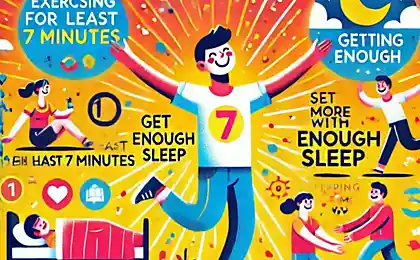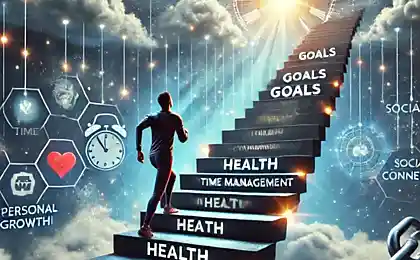193
7 ways to get rid of self-pity to become happier and more successful
If you constantly feel sorry for yourself, you can live a life of negativity and failure. To prevent this from happening, fight this habit.
 18
18Self-pity is an emotional trap that almost everyone falls into. We sympathize with ourselves when faced with failure, disappointment, or injustice. However, if this condition becomes chronic, it becomes a destructive force that blocks personal growth and hinders the achievement of goals.
Studies show that people who are prone to self-pity are 40% more likely to experience depression and 60% less likely to achieve their goals. Chronic self-pity creates a vicious cycle: the more we feel sorry for ourselves, the less we act to change the situation.
Psychologist Christine Neff of the University of Texas conducted a large-scale study that showed that people who practice self-compassion instead of self-regret show higher rates of psychological well-being, motivation and resistance to stress. The difference between these concepts is cardinal: self-compassion encourages action, and self-pity paralyzes.
The Anatomy of Self-Pity: Why We Fall into This Trap
Self-pity activates ancient survival mechanisms in our brains. When we feel threatened or hurt, the limbic system triggers a defensive response. In prehistoric times, it helped conserve energy after injury. Today, this mechanism often works against us, causing us to get stuck in negative experiences.
“A person who feels sorry for himself becomes a prisoner of his own emotions. He spends energy on experiences instead of using it to solve problems. Martin Seligman, founder of positive psychology
Neurobiological studies have revealed an interesting fact: when we plunge into self-pity, the brain’s default system, the network of neurons responsible for rumination and self-critical thoughts, is activated. At the same time, the activity of the prefrontal cortex, responsible for decision-making and planning, decreases.

Seven Science-Based Ways to Overcome Self-Pity
1st
Stop-question-action technique
When you notice that you are beginning to feel sorry for yourself, stop immediately and ask three questions: “What exactly can I control in this situation?”, “What specific action will bring me closer to a solution?” and “What would I advise my best friend in a similar situation?” This algorithm switches the brain from rumination mode to problem solving mode.
Lifehack: Start an action log – Write down three specific things you can do every day to improve your situation, even if they seem insignificant.
2.
"External observer" practice
Imagine watching your situation from the outside, like a documentary filmmaker making a film about someone’s life. This technique, based on the principles of cognitive behavioral therapy, helps to create emotional distance and see the situation more objectively. Studies show that people using this technique are 30% faster at finding constructive solutions.
Practical exercise: Describe your problem in the third person, beginning the sentences with the words “This person faced ...” You will be surprised how different the situation will be.
3
The “Temporary Perspective” method
Self-pity distorts the perception of time, leading one to believe that current problems will last forever. Psychologist Hal Erskine has developed a technique for time scaling: ask yourself if this problem will bother you in 10 years, 5 years, a year, a month. Most daily frustrations lose their destructive power with this approach.
4.
Cultivating “Growth through Testing”
The concept of post-traumatic growth, developed by psychologists Tedeschi and Calhoun, shows that people can not only recover from injuries, but also become stronger. Instead of asking “Why did this happen to me?” ask “What does this teach me?” and “How can I use this experience to help others?”
Exercise "Gifts of difficulties": Each week, write down three skills, qualities, or insights you’ve gained through current challenges.

5
The "Active Compassion" technique
Replace self-pity with self-compassion in action. Christine Neff’s research suggests that self-compassion includes three components: mindfulness (recognition of pain without drama), community of human experience (understanding that suffering is a part of everyone’s life), and kindness (treating oneself as a good friend).
The mantra of self-compassion: “This is a painful moment. Pain is part of human life. May I be kind to myself during this difficult time. ?
6
The Positive Reinterpretation Method
Neuroplasticity of the brain allows you to retrain neural pathways. Instead of automatically thinking, “I’m a loser,” train to think, “I’m learning and evolving.” Studies show that the systematic practice of positive reinterpretation literally changes the structure of the brain in 8-12 weeks.
7
Creating a “Support and Action System”
Self-pity thrives in isolation. Create a support network of people who will not only comfort, but also motivate to act. A Harvard study found that people with strong social connections are 50 percent more resistant to depression and twice as quick to overcome crises.
The 24-hour rule: Give yourself a maximum of 24 hours to experience failure, then be sure to share the situation with someone who can help find a constructive solution.
Stories of Transfiguration: From Pity to Power
Maria, a 34-year-old marketer, lost her job during the economic crisis. She spent the first two months in self-pity, blaming circumstances and feeling like a victim. Using the “Outside Observer” method, she realized that dismissal is an opportunity to change the field of activity to a more interesting one. Six months later, Maria launched her own business in the field of environmental marketing, which began to bring in twice as much revenue.
Alexey, a programmer, has been feeling sorry for himself for years because of failures in his personal relationships. Using the Growing Through Trials technique, he realized that each breakup taught him to better understand himself and his needs. This knowledge helped him build a strong relationship with a partner he has been happy with for five years.
Conclusion: from the victim to the creator of his destiny
Getting rid of self-pity is not the suppression of emotions, but their transformation into a constructive force. Each of the seven methods is a tool for reprogramming thinking from “victim of circumstances” to “creator of one’s own life.”
Remember, change takes time and practice. The brain needs 21-66 days to form new neural connections. Start with one method, practice it daily, and gradually add the rest.
Your life is not a series of random events, but a sequence of choices. And every new day is an opportunity to choose strength over weakness, action over inaction, growth over stagnation.
Glossary of terms
Rumination Obsessive rethinking of negative thoughts and experiences, which does not lead to a solution to the problem.
limbic system A complex of brain structures responsible for emotions, motivation and memory.
Prefrontal cortex The area of the brain responsible for decision-making, planning, and impulse control.
Brain failure A network of brain areas active at rest and associated with self-referential thinking.
Cognitive behavioral therapy A psychotherapeutic approach aimed at changing dysfunctional thought patterns and behavior.
Post-traumatic growth Positive psychological changes that can occur as a result of dealing with serious life challenges.
Neuroplasticity The ability of the nervous system to change its connections and behavior in response to new information, sensory stimulation, development, damage, or dysfunction.
Self-compassion A kind, understanding attitude towards oneself in moments of suffering or failure, without judgment or self-criticism.
5 signs that the reason for your loneliness is indecision
Jocelyn Reiter: When passion for horses eclipses the catwalk























